Multi-tiered onions - varieties, cultivation and storage
Perennial species Luke there are a lot of greens with their own advantages, disadvantages, taste. But little is known about the viviparous, Egyptian perennial onion. The multi-tiered onion got its name from the appearance of bulbs at the ends of the feathers, which again begin to grow upward, giving rise to new bulbs, and the plant has several such floors.
Such a vegetable is loved for its early appearance in the beds, for the sharp juiciness of the feathers, bulbs, which are ideal for pickling. Growing the plant is effective both for using its original properties in health promotion and for use in cooking.
Content:
- General description of the multi-tiered bow
- Plant varieties, their features
- Creating conditions for growing onions
- Breeding methods, planting in open ground
- Green vegetable care
- Fight against diseases, pests of garden plants
- Harvesting dates, storage methods
General description of the multi-tiered bow
The multi-tiered plant does not differ at all from its counterparts in the onion shop, it has the same beneficial properties, the same bitterness when using feathers and bulbs. But in appearance it is quite interesting:
- In place of the inflorescences at the ends of the arrows, small airy fruits appear, which release green feathers, similar to horns. This is how the second tier of the plant begins, so a third, fourth can be formed, but the bulbs will become smaller and smaller.
- A bulb located underground is characterized by some looseness, medium size, and it eventually divides into 2-4 parts, but has poor keeping quality. Aboveground ones are dense to the touch, have a pungent taste, and are stored for a long time.
- This type of onion does not have a dormant period, therefore, at any time of the year, it lets airy fruits on the feather, giving it instantly.
- Feature root system vegetable is its development, by the third year of life it reaches a length of one and a half meters.
- Green onion feathers become coarse much later than that of a batun.
The multi-tiered vegetable is suitable for growing even in cold climates, it is appreciated for its multifunctional use, early ripening.
Plant varieties, their features
Breeders are working on the development of new varieties of multi-tiered onions, the most popular are currently considered:
- Suitable for distribution in vegetable gardens, fields of the Urals, Siberia cold-resistant species - Gribovsky 38. The first layer of green leaves reaches a height of forty centimeters, the second and third - a little less. Three weeks after the snow melts, you can use onion feathers for food.
- Breeders are proud of the Likov variety. It has such qualities as early ripeness, resistance to frost, lodging of feathers. In a little more than 20 days, leaves with a pungent taste grow back, up to 45 centimeters long. More than eight air bulbs appear on the arrow, so that up to four kilograms of light purple bulbs can be harvested from one square meter.
- For the southern regions, the cultivation of Odessa winter onions is suitable, in which the underground red-violet tone of the bulb has many rudiments, and the bush is dense with greenery, which rises to a height of over 40 centimeters.
- The early-maturing Pamyat variety has medium-sized purple bulbs, and the underground bulb produces lush greenery.
All varieties of multi-tiered onions have much in common, but differ in taste, color, and bulb size.
Creating conditions for growing onions
Egyptian onions have their own preferences for the soil in which they will grow. The soil on the bed should be neutral, fertile, for which it is fertilized with organic substances before planting.
By planting a plant in an open, well-lit area, you can harvest it for five years. Onions give the first greens early, as soon as the snow melts, therefore, the place of growth should be chosen taking into account this quality: on a hill, with good warming up by the sun.
Arrows appear on the plant in the second year of life from the end of April to June, and in the second half of summer, a second tier of air bulbs is formed.
Although this type of onion is not afraid of frost, but sudden temperature changes in spring are dangerous for it, so it is best to cover the vegetable beds with foil. Only well-rooted bulbs will survive the frosty winter even under a thin cover of snow. The plant grows well, gives a rich harvest in warm and humid climates.
Breeding methods, planting in open ground
The perennial is propagated by the vegetative method - bulbs of the second, third tier, dividing the bush... In the last decade of August - early September, bulbs are prepared for planting, so that they have time to take root by winter, and gain a foothold in the soil. Collect the bulbs for planting before they begin to germinate. The material must be dried, folded into a paper bag, placed in the lower part of the refrigerator.
Landing rules:
- When planting in open ground, the bed is loosened, a sufficient amount is introduced into it organic fertilizers.
- Then, to a depth of four centimeters, the bulbs are placed at a distance of ten centimeters from each other.
- In the greenhouse, the bulbs are planted back to back in the form of a bridge. Up to two kilograms of green feathers are harvested from a kilogram of planting material.
In spring, the onion is propagated by dividing the bush into parts, seeding each fraction of the mother bulb separately. The best planting option is after the rain so that the roots of the plant quickly take root. To build up an underground bulb, it is practiced to cut off the feather along the outer row of the stem, leaving the central part.
Many gardeners advise using a staggered arrangement for planting onions on the site.
In moist soils, the beds are made high. Fertilizers are applied before planting for one square meter, two buckets of humus, twenty grams of potassium salt, ammonium nitrate, thirty - superphosphate. In heavy soils, add a bucket of river sand. Correct planting of onions in good weather, followed by moistening the soil, will allow you to achieve high yields of a spicy vegetable.
Green vegetable care
The unpretentiousness of the plant helps it survive even with poor care, but the harvest of pleasant bulbs and delicate feathers can be obtained by observing some rules:
- You can increase the cutting time of greens using glazeespecially during dry periods.
- The beds with onions must be loosened, removed from them weeds.
- A multi-tiered vegetable with a strong growth is thinned out, planting parts of the mother plant on new ridges.
- Top dressing produced in early spring and twice after cutting. It includes nitrophoska fertilizer, which is applied either on melting snow or during watering.
- When arrows, burdened with air bulbs, appear, they are tied to pegs to avoid lodging of leaves.
- Before the first frost begins, the soil in the onion beds is well loosened to kill the onion fly larvae.
Fight against diseases, pests of garden plants
To the main diseases from which it suffers onion, include those caused by various fungi. They affect roots, bulbs, leaves. If you see yellow feathers in a perennial, then this peronospora has covered the planting of the vegetable, and in a week all the plants will be infected. Premature dying off of a plant's feathers leads to underdevelopment of the bulbs, a decrease in yield. Such diseases must be prevented by spraying with a 1% solution of Bordeaux mixture.
The main pest is the onion fly, which lays eggs near plants or between leaves. Bulbs affected by the larva then rot. To scare off flies, use naphthalene.
By properly caring for the onion beds, you can avoid its infection with diseases, protect it from pest attacks.
And the onion weevil, a beetle with a long proboscis, spends the winter in dried leaves, grass, and in the spring it eats leaves together with its larvae, which turn yellow and dry up. Thorough cleaning of garbage, foliage after cleaning the garden will keep the vegetable planting healthy.
Harvesting dates, storage methods
Ripe aboveground bulbs are harvested during the ripening period of the arrows after the tenth of August, when they become covered with a bluish bloom, become brown with a reddish tint. The arrow dies off, and two halves of the bulb can be used for planting.
Store the multi-tiered bow at a temperature of at least two degrees below zero in cellars or pits under a layer of sand.
In a warm room, the bulbs germinate and die. Many people use bulbs for winter plantings. on the windowsillsbecause there is no peace for them, they are always ready for growth.
More information can be found in the video:



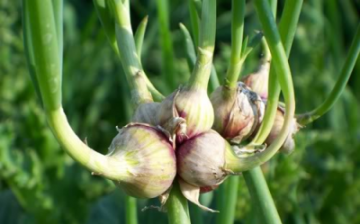
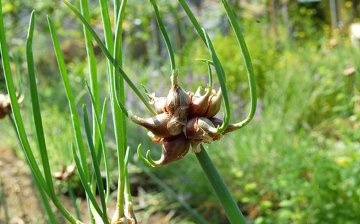
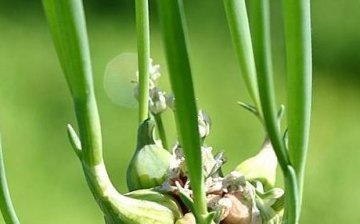

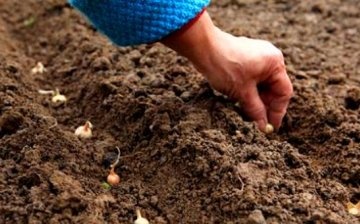
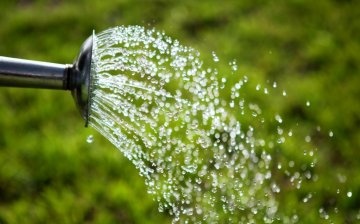
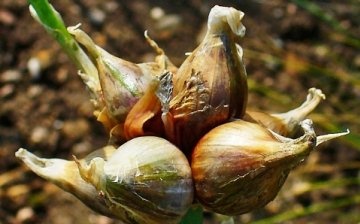
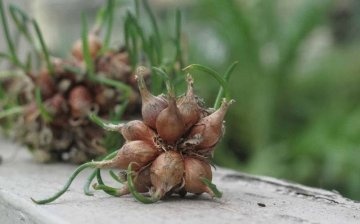









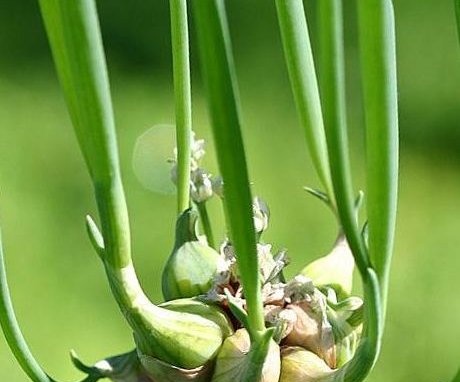


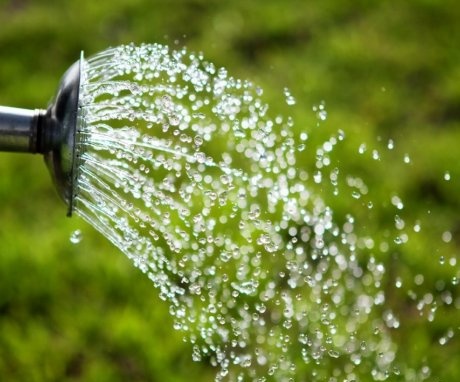
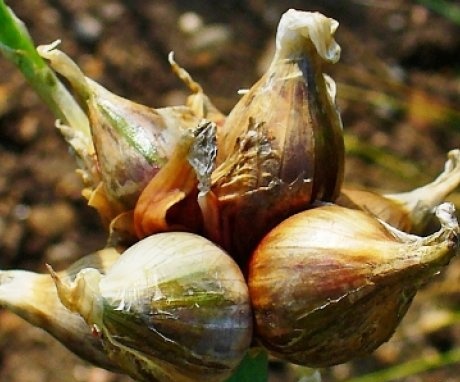

I have never heard of such an unusual, multi-tiered bow. Apparently, it needs to be tied like tomatoes to some kind of support, because the bulbs with their weight can easily break the weak feather of the onion.